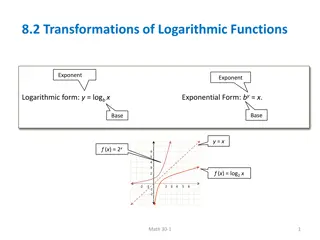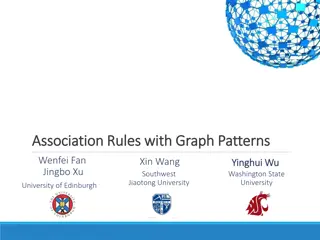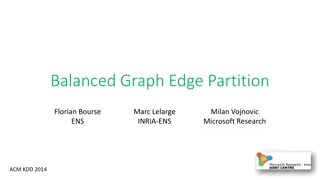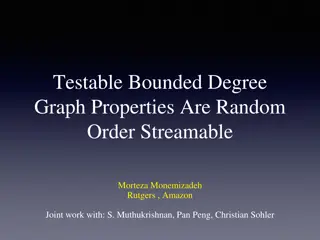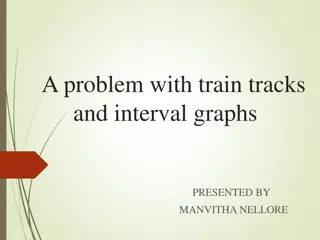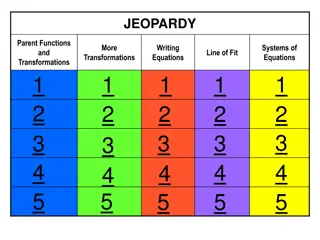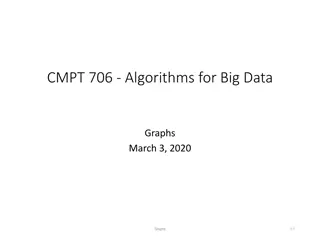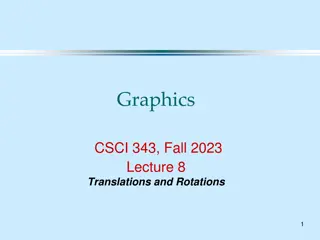
Recognise and Sketch Trig Graph Transformations Easily
Learn to recognize and sketch transformations of trigonometric graphs effortlessly. Understand how factors like stretching, reflection, and shifting affect sine and cosine functions. Improve your trigonometry skills with clear explanations and visuals.
Download Presentation

Please find below an Image/Link to download the presentation.
The content on the website is provided AS IS for your information and personal use only. It may not be sold, licensed, or shared on other websites without obtaining consent from the author. If you encounter any issues during the download, it is possible that the publisher has removed the file from their server.
You are allowed to download the files provided on this website for personal or commercial use, subject to the condition that they are used lawfully. All files are the property of their respective owners.
The content on the website is provided AS IS for your information and personal use only. It may not be sold, licensed, or shared on other websites without obtaining consent from the author.
E N D
Presentation Transcript
Trig graph Transformations
Trigonometry BAT recognise and sketch transformations to trig graphs KUS objectives Starter: Sketch graphs of the sine, cosine and tangent functions Put all the key values on the x axis Put any other key points on the graphs stationary points Write the period of each graph Give some equations of asymptotes for the tangent function
Transformations 1 y y = sin You need to be able to recognise transformations of graphs, and sketch them 1 0 360 90 180 270 -1 Transformation type 1 y 3 = = sin sin y = 3sin y y a This stretches the graph vertically by a factor a . 0 360 90 180 270 y values 3 times as big = 3sin y -3 1sin 2 y = sin = y y values halved y 0.5 0 Multiplying sin by a number will affect the y value directly 360 90 180 270 -0.5
Transformations 2 y y = sin You need to be able to recognise transformations of graphs, and sketch them 1 0 360 90 180 270 -1 Transformation type 1 y = = sin sin y y a y = -sin 1 This stretches the graph vertically by a factor a . 0 360 90 180 270 Reflection in the x axis -1 = sin y (all the y values will swap sign ) y y = sin(- ) 1 Reflection in the y axis = sin( ) y 0 360 90 180 270 (You get the same y values for the reversed x value. -90 gives the result 90 would have) -1
Transformations 3 y y = cos You need to be able to recognise transformations of graphs, and sketch them 1 0 360 90 180 270 -1 Transformation type 1 y = = cos cos y y a y = -cos 1 This stretches the graph vertically by a factor a . 0 360 90 180 270 Reflection in the x axis -1 = cos y y y = cos(- ) 1 Reflection in the y axis = cos( ) y 0 360 90 180 270 -1
Transformations 4 y y = sin You need to be able to recognise transformations of graphs, and sketch them 1 0 360 90 180 270 -1 Transformation type 2 y y = sin + 1 = = + sin sin y y a 1 This shifts the graph vertically a units. It is important to note that the a is added on AFTER doing sin 0 360 90 180 270 -1 Y values all increase by 1 = + sin 1 y y y = -2 + sin -1 Y values all decrease by 2 = + 2 sin y -2 Adding an amount onto sin is a vertical shift -3
Transformations 5 y y = sin You need to be able to recognise transformations of graphs, and sketch them 1 0 360 90 180 270 -1 Transformation type 3 90 y y = sin( + 90) = = + sin sin( ) y y a 1 This shifts the graph horizontally -a units. NOTE: The a is added to before we work out the sine value 0 360 90 180 270 -1 y takes the same set of values, for values of that are 90 less than before y takes the same set of values, for values of that are 30 more than before = + sin( 90) y y 30 y = sin( 30) 1 = sin( 30) y 0 360 90 180 270 -1 Adding/Subtracting an amount from the bracket is a horizontal shift
Transformations 6 y y = sin You need to be able to recognise transformations of graphs, and sketch them 1 0 360 90 180 270 -1 Transformation type 4 y y = sin2 = = a sin sin( ) y y 1 This stretches the graph horizontally by a factor 1/a 0 90 180 270 360 Same set of y values, for half the values -1 = sin(2 ) y y y = sin( /3) Same set of y values, for triple the values = sin y 3 1 0 1080 270 540 810 Multiplying or dividing in the bracket is a horizontal stretch/squash -1
WB 15 (90, 1.5) y y = sin + k You need to be able to answer questions with unknowns in 1 0 360 90 180 270 -1 The graph shows the Function: f(x) = Sin + k a) Write down the value of k 0.5 (Graph 0.5 units higher) b) What is the smallest positive value of that gives a minimum point? 270 c) What is the value of Sin at this point? -0.5
WB 16 y y = cos( +k) You need to be able to answer questions with unknowns in 1 y 70 250 x 0 The graph shows the Function: -1 f(x) = Cos( + k) f(x) = Cos( + k) We know k On the y axis, = 0. a) Write down the value of k 20 (Graph moved 20 units left) f(x) = Cos( + 20) b) What is the value of at x? x = 250 c) What are the coordinates of the minimum? (160, -1) d) What is the value of Cos at y intercept? f(x) = Cos( + 20) f(x) = Cos(20) Work out the answer! f(x) = 0.94 (2dp)
KUS objectives BAT know the key features of trig graphs using both degrees and radians BAT use exact values of trig functions to solve problems BAT recognise and sketch transformations to trig graphs self-assess One thing learned is One thing to improve is






